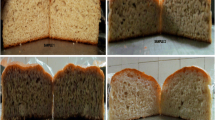Abstract
Manufacturing of bread from rice flour only presents technological difficulty because the rice is gluten-free and gluten is the most important structure forming protein. By using wheat and rice flour mixture, this problem can be avoided, and end product is enriched by rice-oil constituents. In this paper fatty acids composition, with an emphasis on total saturated, and total unsaturated fatty acids, rheological and baking properties of wheat–rice flour mixture (70:30 w/w) were investigated. The results show that wheat–rice flour mixture has better fatty acids composition with higher content of stearic, arachidic, lignoceric, oleic, and phthalic acids compared to wheat flour. Also, wheat flour did not include myristic, arachidic, lignoceric and linolenic acids, so rice flour addition made fatty acids profile richer as number of constituents is higher, nine instead six. The content of total unsaturated fatty acids content was higher in wheat–brown rice flour mixture than in wheat flour and in wheat–white rice flour mixture. When rice flour was added to wheat flour the rheological properties were changed: flour mixture had less water absorption, less degree of softening, longer development time, higher gelatinization temperature, but better stability and finally, better quality number and group than wheat flour. So, the wheat and rice flour mixture can be considered as a good quality flour and can be used for making good quality wheat-rice bread and cake.

Similar content being viewed by others
Abbreviations
- TS:
-
Total saturated fatty acids
- TMUS:
-
Total monounsaturated fatty acids
- TPUS:
-
Total polyunsaturated fatty acids
- TU:
-
Total unsaturated fatty acids
- WA:
-
Water absorption
- DT:
-
Development time
- DSt:
-
Dough stability
- DSf:
-
Degree of softening
- QN:
-
Quality number
- E:
-
Energy
- R :
-
Resistance
- Ex:
-
Extensibility
- T max :
-
Gelatinization temperature
- η max :
-
Viscosity
- HV:
-
Holding” value, as ratio of height and diameter
- PC:
-
Protein content
- GC:
-
Gluten content
- OC:
-
Oil content
- W:
-
Wheat flour
- WWR:
-
Wheat–white rice flour mixture
- WBR:
-
Wheat–brown rice flour mixture
References
Vegan Society, 2007, Essential fatty acids, Retrieved June 22, 2001 from the World Wide Web: http://www.vegansociety.com/html/food/nutrition/e_fatty_acids.php
Kitta K, Ebihra M, Iizuka T, Yoshikawa R, Isshiki K, Kawamoto S (2005) J Food Compost Anal 18:269–278
Piggott JR, Morrison WR, Clyne J (1991) Int J Food Sci Technol 26:615–628
Zhou Z, Blanchard C, Helliwell S, Robards K (2003) J Cereal Sci 37:327–335
Sotelo A, Sousa V, Montalvo I, Hernandez M, Hernandez-Aragon L (1990) Cereal Chem 67(2):209–212
Goffman FD, Pinson S, Bergman CJ (2003) Am Oil Chem Soc 80(5):485–490
Rice oil, 2007, Retrieved June 22, 2007 from the World Wide Web: http://www.ricebranoil.info.
Wilson TA, Nicolosi RJ, Woolfrey B, Kritichevski D (2007) J Nutr Biochem 18(2):105–112
Chata AI, Hussain JR, Bajawa MJ (2006) Food Lipids 13:424–433
Iqbal S, Bhangaer MI, Anwar F (2005) Food Chem 93:265–272
International Rice Research Istitute (IRRI), Retrieved February 7, 2005 from the World Wide Web:http://www.irri.org/science/science/recestat/
Hema PS, Senge B, Chattopadhyay PK (2004) J Food Eng 62:37–45
Gujural HS, Guardioola I, Carbonelll JV, Rosell CM (2003) J Agric Food Chem 51:3814–3818
Schober TJ, O’Brien CM, McCarthy D, Darnedde A, Arendt EK (2003) Eur Food Res Technol 216:369–376
Dobraszczyk BJ, Morgenstern MP (2003) J Cereal Sci 38:229–245
Brooker B (1996) Cereal Sci 24:187–189
Daglioglu O, Tasan M (2003) Eur Food Res Technol 217:125–127
Zhou Z, Robards K, Helliwell S, Blanchard C (2007) Food Res Intern 40:209–214
Indrani D, Rao V (2007) J Food Eng 79:100–105
Acknowledgements
This work was supported under the project by the Ministry of Science and Environment Protection of the Republic of Serbia.
Author information
Authors and Affiliations
Corresponding author
Rights and permissions
About this article
Cite this article
Nikolić, N., Radulović, N., Momcilović, B. et al. Fatty acids composition and rheology properties of wheat and wheat and white or brown rice flour mixture. Eur Food Res Technol 227, 1543–1548 (2008). https://doi.org/10.1007/s00217-008-0877-z
Received:
Revised:
Accepted:
Published:
Issue Date:
DOI: https://doi.org/10.1007/s00217-008-0877-z




